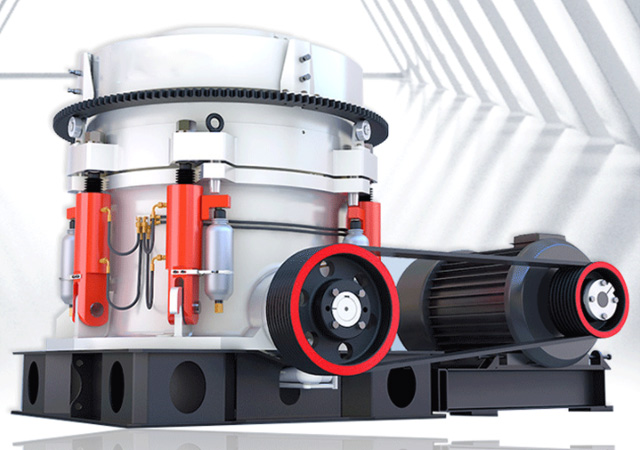A cone crusher is a type of secondary crusher that takes medium grained feed from a primary crusher and then further crushes the material into finer particles. It consists of an outer concave, a mantle, a main shaft, and an eccentric bearing, as well as a bowl liner, which is used to protect the crusher’s internal parts from wear.

Design:
- Frame and Main Shaft: The frame of the cone crusher supports the main shaft and other components. It is typically made of cast steel or iron. The main shaft, usually made of high-grade forged steel, is supported by bearings at both ends. The main shaft is connected to the crushing cone (mantle) and rotates eccentrically within the frame.
- Mantle and Concave: The crushing cone, or mantle, is mounted on the main shaft and is held in place by a large concave. The concave is shaped like a bowl and is lined with wear-resistant manganese steel. The space between the mantle and concave is the crushing chamber, where the material is crushed.
- Eccentric Assembly: An eccentric assembly, typically driven by a motor, causes the main shaft and consequently the mantle to move in a circular motion. This eccentric motion creates a compression crushing force between the mantle and the concave, effectively breaking down the material.
- Bowl Liner: The bowl liner is another crucial component made of manganese steel. It protects the main frame and concave from wear caused by the crushed material.
- Adjustment Mechanism: Cone crushers are equipped with an adjustment mechanism that allows the operator to adjust the size of the discharge opening. This adjustment is essential to control the product size and ensure optimal performance. Modern cone crushers often feature hydraulic systems for easy and precise adjustments.
Working Principle:
- Feed Hopper: Material is fed into the cone crusher through a feed hopper. The size of the material can vary, but it is usually a secondary or tertiary crushing stage after the primary crusher.
- Crushing Chamber: Once inside the crushing chamber, the material encounters the rotating mantle and is crushed between the mantle and the stationary concave. The crushing action is continuous, as the mantle moves eccentrically.
- Size Reduction: The eccentric motion of the mantle creates a compression crushing force, reducing the size of the material. The crushed material falls through the bottom opening, known as the discharge opening.
- Discharge Opening Adjustment: The operator can adjust the discharge opening to control the product size. A smaller discharge opening produces finer material, while a larger opening results in coarser material.
- Release of Unbreakable Material: In the case of unbreakable or tramp material, the cone crusher is equipped with a release system that allows the unbreakable material to pass through the crushing chamber without damaging the crusher.
Cone crushers are essential equipment in the mining and aggregate industries for their efficient and reliable crushing action. Their robust design, with features like the eccentric assembly and adjustment mechanisms, ensures a high level of performance and versatility in various crushing applications.
